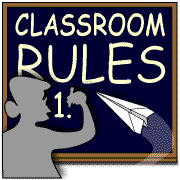 Every teacher has their own classroom management procedures and they no doubt will fit their particular personality. The skills listed below are very general principles that apply to any method that you may choose and will have beneficial affects on the classroom and the students as well as the teachers morale.
Every teacher has their own classroom management procedures and they no doubt will fit their particular personality. The skills listed below are very general principles that apply to any method that you may choose and will have beneficial affects on the classroom and the students as well as the teachers morale.
Rearranging the Environment: There are some personalities that should not sit next to each other in a learning environment. There may be, depending on the age other arrangements that can be made too, like sitting in a circle or huddled up with the teacher that may be affective. How we line the kids up or transitions in the class can all be looked at to see if there may be another way for them to be done to reduce bullying.
 Establishing Clear Classroom Rules: Setting expectations for students is important so there is no doubt in their mind of what their conduct should be in this environment. Some may choose to have a set of rules and others may have a single principle that they attempt to live by like, “Do unto others……, In my classroom I use single words. Respect, Discipline, Control and Focus are my favorite. They can be asked simply by saying “Does that show respect?”
Establishing Clear Classroom Rules: Setting expectations for students is important so there is no doubt in their mind of what their conduct should be in this environment. Some may choose to have a set of rules and others may have a single principle that they attempt to live by like, “Do unto others……, In my classroom I use single words. Respect, Discipline, Control and Focus are my favorite. They can be asked simply by saying “Does that show respect?”
Being Consistent: Consistencies take on two aspects. The first is, if you have a rule it must apply to all the children. That does not mean that you are not sensitive to students who may have special needs. But in a kind manner the rules and the consequences should be meted out equally. Second is our own behavior. As instructors we should demonstrate for our students how to treat others with respect. We must demonstrate the discipline and control we want them to show. Students will look at our example to see if we bully or not.
Using Clear, Polite, Specific Language: The language and attitude we have when we need to discipline sets the example for the students. The student must believe that the teacher means what they say. At the same time the way it is said should be with politeness and yet firm. General statements may not work, whereas simple short concise requests are more easily understood. One more part of this is letting them know what we expect and not asking a student if they want to do something. Expressing what you expect helps to avoid escalating any conflict. It show too that we are not a bully.
Being Respectful of Students: When we treat students with respect we are giving them the opportunity to learn to treat others with respect. Also in doing so they can develop self worth, feel valuable, and learn positive ways of treating others.
Showing That You Value Students: Acknowledging your students and speaking with them directly makes the student feel connected to the school and the teacher. One way of doing that is knowing what is of value to the students and talking to them about it. Another way is to try to have personal one on one contact with each student at least 3 times every day. Whether that is by speaking directly, a touch or a thumbs up, each of these lets the student know that you are connected to them. Bullies need to know that we care about them just as much as the other students in the class. That can be hard at times. But remember that every child in the class is watching to see how we react to our most difficult student.
Avoiding Public Confrontations: Getting into a power struggle or trying to correct the bullying student in front of his classmates will only increase the amount of bad feelings that the student has for the victim and the teacher. We must stop the bullying at the moment we see it occur, but dealing with consequences and discipline publicly will only make the student feel embarrassed in front of their classmates and possibly increase the aggression.
 Teaching New Skills: Surprisingly students come to school and teachers many times with very few social and life skills. While it is our responsibility to teach academic skills, it is the people skills, problem solving skills, and social skills that will have the bigger and more long term affect on their ultimate success. No matter the subject we teach academically, as teachers we can also teach all of the soft skills at the same time. Doing so will help our classroom and the student.
Teaching New Skills: Surprisingly students come to school and teachers many times with very few social and life skills. While it is our responsibility to teach academic skills, it is the people skills, problem solving skills, and social skills that will have the bigger and more long term affect on their ultimate success. No matter the subject we teach academically, as teachers we can also teach all of the soft skills at the same time. Doing so will help our classroom and the student.
While we have focused on the teacher and the classroom in this post, all of these are true for parents too. In future posts we will expand on these steps and teaching skills for parents and teachers. As parents we are our children’s most important teachers. Both by our word and our example we are showing them the way we believe they should conduct themselves and live their life.

